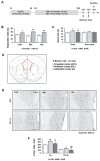Effects of exercise intensity on the reactive astrocyte polarization in the medial prefrontal cortex
- PMID: 37583068
- PMCID: PMC10440185
- DOI: 10.20463/pan.2023.0014
Effects of exercise intensity on the reactive astrocyte polarization in the medial prefrontal cortex
Abstract
Purpose: Physical exercise contributes to neuroplasticity by promoting cognitive functions, such as learning and memory. The astrocytic phenotype is closely associated with synaptic plasticity. This study aimed to determine whether astrocyte polarization and synaptic alterations in the medial prefrontal cortex (mPFC) are affected differently by high- and moderate-intensity exercise.
Methods: Mice were subjected to moderate-(MIE) and high-intensity treadmill running (HIE). Memory capacity was assessed using the novel object recognition and modified Y-maze tests. For immunohistochemistry, c-Fos-positive cells were counted in the mPFC. Using western blot analysis, astrocyte phenotype markers were quantified in whole-cell lysates, and synaptic molecules were determined in the synaptosomal fraction.
Results: Exercise lengthened the approach time to novel objects regardless of intensity in the NOR test, whereas MIE only improved spatial memory. Exercise induced c-Fos expression in the anterior cingulate cortex (ACC) and c-Fos-positive cells were higher in MIE than in HIE in the ACC area. In the prelimbic/infralimbic cortex region, the number of c-Fos-positive cells were enhanced in MIE and decreased in HIE mice. The A1 astrocyte marker (C3) was increased in HIE mice, while the A2 astrocyte markers were enhanced in exercised mice, regardless of the intensity. In the synaptosomal fraction, synaptic proteins were elevated by exercise regardless of intensity.
Conclusion: These results suggest that exercise intensity affects neuronal plasticity by modulating the reactive state of astrocytes in the mPFC.
Keywords: astrocyte phenotype; exercise intensity; memory; neuronal activity; prefrontal cortex; synapse formation; treadmill running.
Figures


Similar articles
-
High-intensity treadmill running impairs cognitive behavior and hippocampal synaptic plasticity of rats via activation of inflammatory response.J Neurosci Res. 2017 Aug;95(8):1611-1620. doi: 10.1002/jnr.23996. Epub 2016 Dec 5. J Neurosci Res. 2017. PMID: 27918079
-
Treadmill Exercise Prevents Decline in Spatial Learning and Memory in 3×Tg-AD Mice through Enhancement of Structural Synaptic Plasticity of the Hippocampus and Prefrontal Cortex.Cells. 2022 Jan 12;11(2):244. doi: 10.3390/cells11020244. Cells. 2022. PMID: 35053360 Free PMC article.
-
Positive effects of running exercise on astrocytes in the medial prefrontal cortex in an animal model of depression.J Comp Neurol. 2022 Dec;530(17):3056-3071. doi: 10.1002/cne.25397. Epub 2022 Aug 16. J Comp Neurol. 2022. PMID: 35972906
-
Learning-induced intrinsic and synaptic plasticity in the rodent medial prefrontal cortex.Neurobiol Learn Mem. 2020 Mar;169:107117. doi: 10.1016/j.nlm.2019.107117. Epub 2019 Nov 23. Neurobiol Learn Mem. 2020. PMID: 31765801 Free PMC article. Review.
-
The Three Musketeers in the Medial Prefrontal Cortex: Subregion-specific Structural and Functional Plasticity Underlying Fear Memory Stages.Exp Neurobiol. 2022 Aug 31;31(4):221-231. doi: 10.5607/en22012. Exp Neurobiol. 2022. PMID: 36050222 Free PMC article. Review.
Cited by
-
The role of continuous glucose monitoring in physical activity and nutrition management: perspectives on present and possible uses.Phys Act Nutr. 2023 Sep;27(3):44-51. doi: 10.20463/pan.2023.0028. Epub 2023 Sep 30. Phys Act Nutr. 2023. PMID: 37946446 Free PMC article.
-
Research progress on the role of exercise-regulated reactive astrocytes in the prevention and treatment of Parkinson's disease.Front Aging Neurosci. 2025 Jun 5;17:1561006. doi: 10.3389/fnagi.2025.1561006. eCollection 2025. Front Aging Neurosci. 2025. PMID: 40538417 Free PMC article. Review.
References
-
- Frankland PW, Bontempi B. The organization of recent and remote memories. Nat Rev Neurosci. 2005;6:119–30. - PubMed
-
- Aceti M, Vetere G, Novembre G, Restivo L, Ammassari-Teule M. Progression of activity and structural changes in the anterior cingulate cortex during remote memory formation. Neurobiol Learn Mem. 2015;123:67–71. - PubMed
LinkOut - more resources
Full Text Sources
Miscellaneous

